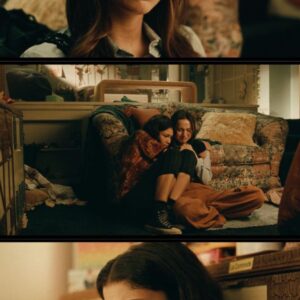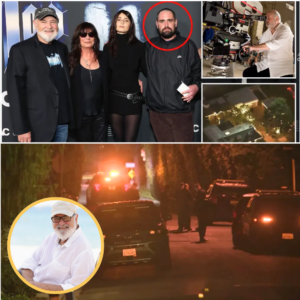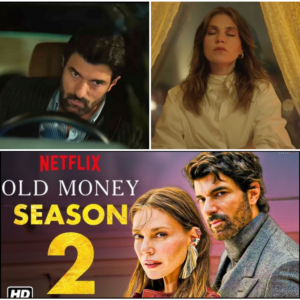In the echoing grandeur of Windsor Castle’s St. George’s Hall, where polished oak floors bear the faint scars of childhood romps, Prince William stepped into a rare spotlight of vulnerability. The setting was no ordinary royal outing but a candid episode of Apple TV+’s The Reluctant Traveler, hosted by the affable Eugene Levy. Amid the castle’s timeless stone walls, the Prince of Wales, at 43, wandered with Levy, sharing stories of boyhood chases with cousins—footsteps thundering across those very floors, splintered wood a badge of innocent mayhem. Yet, in a moment that sent ripples through royal watchers, William uttered his brother’s name for the first time in years: Prince Harry. It was a fleeting reference, laced with quiet resolve, but one that pierced the veil of their long-standing estrangement. As autumn winds swept London’s parks in early October 2025, this single nod to the Duke of Sussex became a beacon—subtle, perhaps, but heavy with unspoken history and the promise of evolution.
The interview, aired just days ago, captured William in his element: reflective, resolute, and remarkably unguarded. Levy, the 78-year-old comic known for his deadpan charm, coaxed out tales of Windsor as a playground of privilege laced with pressure. William evoked the thrill of hide-and-seek in the vast hall, the laughter echoing off tapestries that chronicled centuries of monarchy. But beneath the nostalgia lay a deeper current—the weight of destiny. When Levy posed the inevitable question about his eldest son, Prince George, inheriting the throne one day, William paused, his expression a mosaic of contemplation. “It’s an interesting question, and it’s a big question,” he began, his voice steady yet introspective. “Because there’s lots of things to think about with that.”
What followed was the rarest of royal admissions: a direct invocation of Harry, the younger brother whose departure from the Firm in 2020 shattered the Wales boys’ once-indissoluble bond. “Obviously, I want to create a world in which my son is proud of what we do, a world and a job that actually does impact people’s lives for the better,” William continued. “That is caveated with, I hope we don’t go back to some of the practices in the past that Harry and I had to grow up with—and I’ll do everything I can to make sure we don’t regress in that situation.” The words hung in the air, a gentle rebuke to the rigidities of their shared youth: the relentless media glare that hounded their every step after their mother’s tragic death in 1997, the suffocating protocols that stifled spontaneity, the invisible hand of tradition that often felt more like a cage than a crown.
For those attuned to the brothers’ saga, the subtext was unmistakable. William and Harry, once the world’s most inseparable siblings—united in grief, mischief, and military valor—had forged their early years in the forge of public scrutiny. William, the heir, bore the brunt as the “big one,” while Harry, the spare, navigated shadows of comparison. Their mother’s divorce from King Charles in 1996, when William was just eight, had upended their world, a brief era of stability crumbling into tabloid frenzy. “But you take that and you learn from it and you try and make sure you don’t do the same mistakes as your parents,” William reflected later in the chat, his tone a father’s vow. “I think we all try and do that, and I just want to do what’s best for my children.” Levy nodded knowingly, crediting Princess Diana’s legacy of normalcy—picnics in Kensington Gardens, hugs over protocol—as the seed of William’s philosophy. “Yes, definitely,” William affirmed, a soft smile breaking through.
This ethos of protection permeates William’s life, a bulwark against the tempests that battered his own boyhood. With wife Catherine, Princess of Wales, by his side—herself emerging from a harrowing cancer battle earlier in the year—the couple has cultivated Adelaide Cottage as a sanctuary of simplicity. No sprawling staff, no gilded isolation; instead, packed lunches for school runs, device-free dinners alive with chatter, and weekends blurred by soccer practices, ballet recitals, and hockey sticks. George, now 12 and heir to the heir; Charlotte, 10, the poised empath; Louis, 7, the irrepressible spark—these are the heartbeats of William’s world. He envisions their rhythms unbroken by the intrusions that scarred him and Harry: paparazzi packs at playground gates, headlines dissecting every tumble. “If you let that creep in, the damage it can do to your family life is something that I vowed would never happen to my family,” he has said in past interviews, a mantra etched from experience.
The rift with Harry, however, casts a long shadow over this idyll. What began as fraternal friction—whispers of clashing visions during Harry’s courtship with Meghan Markle—erupted into full schism in January 2020. The Sussexes’ Megxit announcement stunned the palace, a seismic exit that recast Harry as the rebel son, trading tiaras for Montecito’s sun-soaked hills. From there, the wounds multiplied: the 2021 Oprah interview, where allegations of racial bias and isolation surfaced; the 2022 Netflix docuseries peeling back the curtain on royal dysfunction; and Harry’s 2023 memoir Spare, a raw confessional that branded William with accusations of physical altercations and emotional distance. “He wants to be the one in the driver’s seat,” insiders parsed Harry’s grievances, rooted in a lifelong second-fiddle status. William, for his part, viewed the disclosures as a betrayal of trust, a public airing of private pains that risked the monarchy’s fragile equilibrium.
By 2025, the chasm had widened into silence. The brothers’ last joint appearance was the poignant 2021 unveiling of Diana’s statue on her 60th birthday—a stiff-shouldered tableau of forced civility. Harry’s February 2024 dash to London upon Charles’s cancer diagnosis yielded a 30-minute bedside vigil, but no thaw with William. Even as Catherine faced her own health odyssey—abdominal surgery morphing into chemotherapy, her March video a masterclass in grace—the Waleses insulated their circle, prioritizing healing over headlines. Harry’s solo UK pilgrimage in September 2025, a 50-minute tea with his father at Clarence House, sparked flickers of optimism. Palace whispers hailed it as “super positive and very relaxed,” with Harry floating ideas of biannual visits, perhaps ferrying Archie, 6, and Lilibet, 4, for grandfatherly romps. Yet, William remained absent, his aides citing “ongoing tension” born of Spare‘s barbs and perceived breaches. “They are deeply hurt by the public disclosures,” a source confided, “and require significant time to heal.”
William’s Levy interview, then, arrives as a masterstroke of measured diplomacy—not a bridge rebuilt, but a foundation stone laid. By naming Harry, he humanizes the hurt, framing it not as vendetta but as a shared crucible to transcend. “The drama and stress experienced when young really affects individuals later in life,” he mused, linking their past to his paternal drive. This isn’t mere rhetoric; it’s action. Through Heads Together, his mental health crusade, William champions vulnerability as strength, a direct counter to the stoic stiff upper lip that once defined the Windsors. His Earthshot Prize, now a global beacon for environmental innovation, embodies the “impact” he craves for George’s inheritance—a throne not of pomp, but purpose.
Peering ahead, William’s vision crackles with quiet revolution. “It’s safe to say that change is on my agenda,” he told Levy, eyes alight. “Change for good. And I embrace that and I enjoy that change—I don’t fear it. That’s the bit that excites me, is the idea of being able to bring some change. Not overly radical change, but changes that I think that need to happen.” He dreams of a slimmed-down monarchy, attuned to modernity: diverse voices amplified, traditions interrogated, the Firm as facilitator rather than fixture. For George, this means a kingship unburdened by the “practices” that hobbled his father and uncle—perhaps fewer working royals, more emphasis on philanthropy over pageantry, a royal calendar synced to real-world rhythms. “History can be a real weight and an anchor,” William cautioned, urging a gaze toward the “here and now.”
In this, echoes of Harry linger—not as adversary, but ally in reform. Harry’s Invictus Games, his Archewell Foundation’s equity push—these Sussex ventures, for all their controversy, mirror William’s ethos of relevance. Royal biographers speculate that reconciliation hinges on reciprocity: Harry’s silence on the press, a Sussex return to discretion. Holiday hopes simmer; Sandringham’s Christmas could yet host a fireside truce, mince pies thawing old resentments. William, ever the pragmatist, won’t rush. “Everyone copes differently,” he noted of his children’s adaptability during Catherine’s treatment—a lesson extending to fractured kin.
As the episode fades on Windsor’s twilight glow, William’s words resonate beyond the castle’s keep. In breaking silence on Harry, he doesn’t mend the breach overnight but maps a path forward: one of guarded grace, familial fierce, and fearless flux. The brotherhood, once the monarchy’s emotional core, may never reclaim its polo-field camaraderie. Yet, in invoking Harry’s name amid vows of progress, William signals that the past need not dictate the future. For a prince shaped by loss, this is no small gesture—it’s a sovereign’s subtle summons to heal, evolve, and endure. In the grand hall where boys once raced unchecked, the echoes now whisper of possibility: two brothers, divergent paths, one enduring legacy of change.


